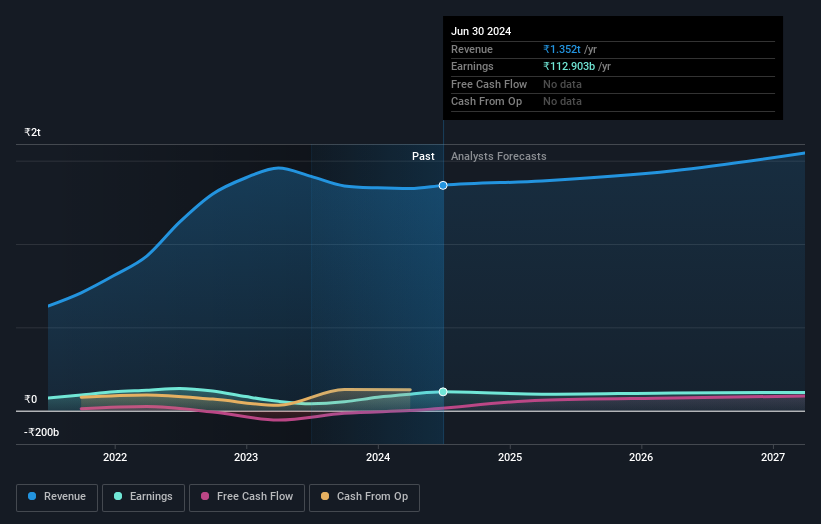- India
- /
- Gas Utilities
- /
- NSEI:GAIL
Results: GAIL (India) Limited Exceeded Expectations And The Consensus Has Updated Its Estimates

As you might know, GAIL (India) Limited (NSE:GAIL) just kicked off its latest first-quarter results with some very strong numbers. The company beat forecasts, with revenue of ₹348b, some 2.3% above estimates, and statutory earnings per share (EPS) coming in at ₹4.84, 54% ahead of expectations. This is an important time for investors, as they can track a company's performance in its report, look at what experts are forecasting for next year, and see if there has been any change to expectations for the business. So we collected the latest post-earnings statutory consensus estimates to see what could be in store for next year.
View our latest analysis for GAIL (India)

Following last week's earnings report, GAIL (India)'s 23 analysts are forecasting 2025 revenues to be ₹1.38t, approximately in line with the last 12 months. Statutory earnings per share are forecast to decrease 9.3% to ₹15.58 in the same period. Before this earnings report, the analysts had been forecasting revenues of ₹1.33t and earnings per share (EPS) of ₹17.11 in 2025. Overall it looks as though the analysts were a bit mixed on the latest results. Although there was a to revenue, the consensus also made a small dip in its earnings per share forecasts.
Curiously, the consensus price target rose 5.6% to ₹220. We can only conclude that the forecast revenue growth is expected to offset the impact of the expected fall in earnings. It could also be instructive to look at the range of analyst estimates, to evaluate how different the outlier opinions are from the mean. Currently, the most bullish analyst values GAIL (India) at ₹285 per share, while the most bearish prices it at ₹148. This is a fairly broad spread of estimates, suggesting that analysts are forecasting a wide range of possible outcomes for the business.
Of course, another way to look at these forecasts is to place them into context against the industry itself. It's pretty clear that there is an expectation that GAIL (India)'s revenue growth will slow down substantially, with revenues to the end of 2025 expected to display 2.6% growth on an annualised basis. This is compared to a historical growth rate of 19% over the past five years. Compare this with other companies in the same industry, which are forecast to see a revenue decline of 3.3% annually. So it's clear that despite the slowdown in growth, GAIL (India) is still expected to grow meaningfully faster than the wider industry.
The Bottom Line
The most important thing to take away is that the analysts downgraded their earnings per share estimates, showing that there has been a clear decline in sentiment following these results. On the plus side, they also lifted their revenue estimates, and the company is expected to perform better than the wider industry. There was also a nice increase in the price target, with the analysts clearly feeling that the intrinsic value of the business is improving.
With that said, the long-term trajectory of the company's earnings is a lot more important than next year. We have forecasts for GAIL (India) going out to 2027, and you can see them free on our platform here.
We don't want to rain on the parade too much, but we did also find 2 warning signs for GAIL (India) (1 shouldn't be ignored!) that you need to be mindful of.
New: Manage All Your Stock Portfolios in One Place
We've created the ultimate portfolio companion for stock investors, and it's free.
• Connect an unlimited number of Portfolios and see your total in one currency
• Be alerted to new Warning Signs or Risks via email or mobile
• Track the Fair Value of your stocks
Have feedback on this article? Concerned about the content? Get in touch with us directly. Alternatively, email editorial-team (at) simplywallst.com.
This article by Simply Wall St is general in nature. We provide commentary based on historical data and analyst forecasts only using an unbiased methodology and our articles are not intended to be financial advice. It does not constitute a recommendation to buy or sell any stock, and does not take account of your objectives, or your financial situation. We aim to bring you long-term focused analysis driven by fundamental data. Note that our analysis may not factor in the latest price-sensitive company announcements or qualitative material. Simply Wall St has no position in any stocks mentioned.
Have feedback on this article? Concerned about the content? Get in touch with us directly. Alternatively, email editorial-team@simplywallst.com
About NSEI:GAIL
GAIL (India)
Operates as a natural gas processing and distribution company in India and internationally.
Solid track record, good value and pays a dividend.
Similar Companies
Market Insights
Community Narratives



